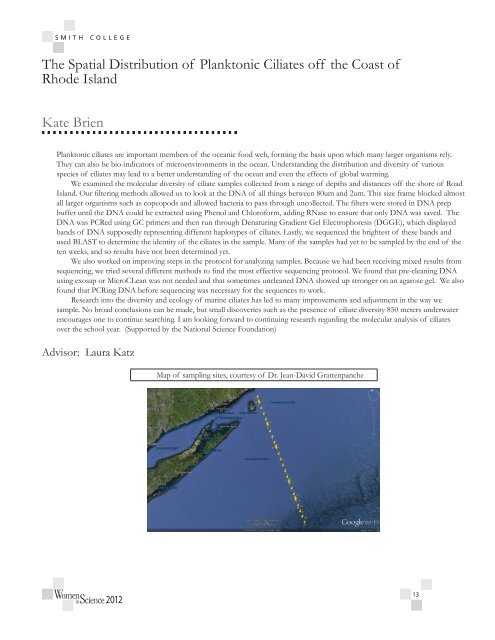Brugia Malayi - Clark Science Center - Smith College
Brugia Malayi - Clark Science Center - Smith College
Brugia Malayi - Clark Science Center - Smith College
You also want an ePaper? Increase the reach of your titles
YUMPU automatically turns print PDFs into web optimized ePapers that Google loves.
The Spatial Distribution of Planktonic Ciliates off the Coast of<br />
Rhode Island<br />
Kate Brien<br />
Planktonic ciliates are important members of the oceanic food web, forming the basis upon which many larger organisms rely.<br />
They can also be bio-indicators of microenvironments in the ocean. Understanding the distribution and diversity of various<br />
species of ciliates may lead to a better understanding of the ocean and even the effects of global warming.<br />
We examined the molecular diversity of ciliate samples collected from a range of depths and distances off the shore of Road<br />
Island. Our filtering methods allowed us to look at the DNA of all things between 80um and 2um. This size frame blocked almost<br />
all larger organisms such as copeopods and allowed bacteria to pass through uncollected. The filters were stored in DNA prep<br />
buffer until the DNA could be extracted using Phenol and Chloroform, adding RNase to ensure that only DNA was saved. The<br />
DNA was PCRed using GC primers and then run through Denaturing Gradient Gel Electrophoresis (DGGE), which displayed<br />
bands of DNA supposedly representing different haplotypes of ciliates. Lastly, we sequenced the brightest of these bands and<br />
used BLAST to determine the identity of the ciliates in the sample. Many of the samples had yet to be sampled by the end of the<br />
ten weeks, and so results have not been determined yet.<br />
We also worked on improving steps in the protocol for analyzing samples. Because we had been receiving mixed results from<br />
sequencing, we tried several different methods to find the most effective sequencing protocol. We found that pre-cleaning DNA<br />
using exosap or MicroCLean was not needed and that sometimes uncleaned DNA showed up stronger on an agarose gel. We also<br />
found that PCRing DNA before sequencing was necessary for the sequences to work.<br />
Research into the diversity and ecology of marine ciliates has led to many improvements and adjustment in the way we<br />
sample. No broad conclusions can be made, but small discoveries such as the presence of ciliate diversity 850 meters underwater<br />
encourages one to continue searching. I am looking forward to continuing research regarding the molecular analysis of ciliates<br />
over the school year. (Supported by the National <strong>Science</strong> Foundation)<br />
Advisor: Laura Katz<br />
Map of sampling sites, courtesy of Dr. Jean-David Grattenpanche<br />
2012<br />
13

















